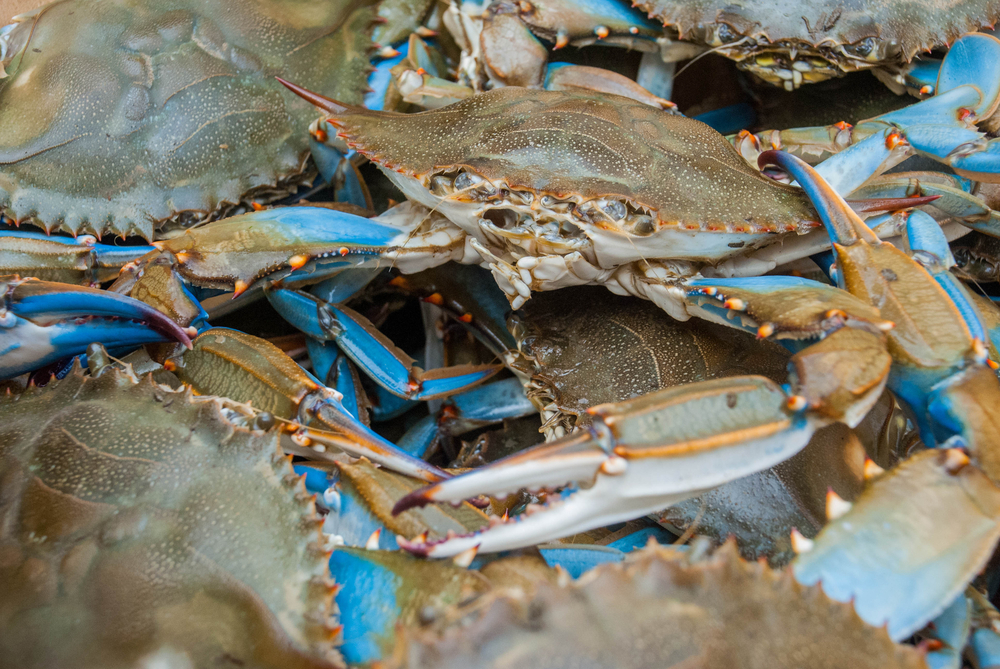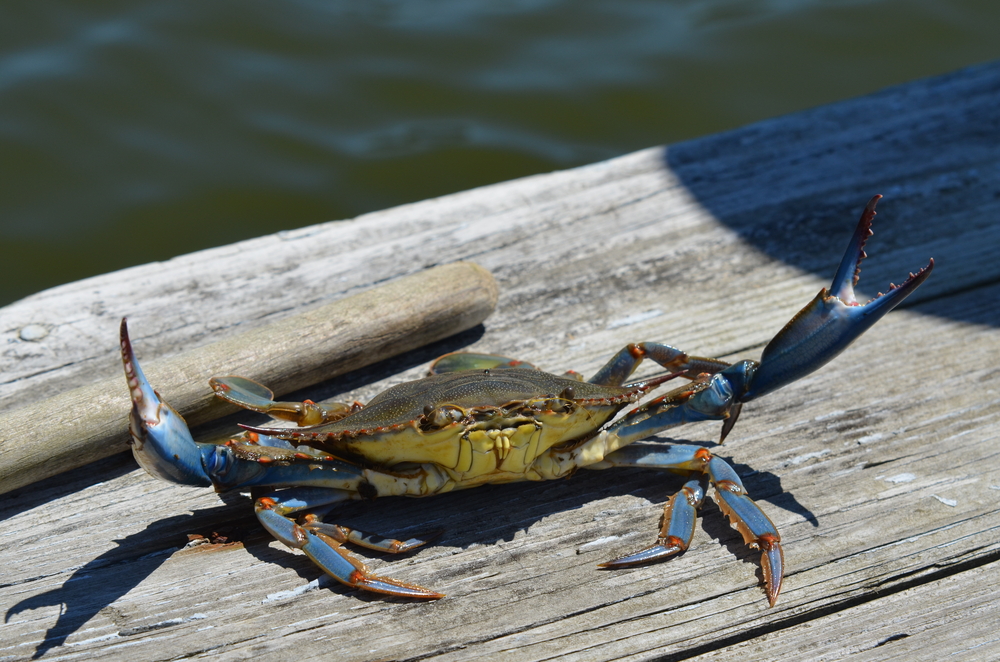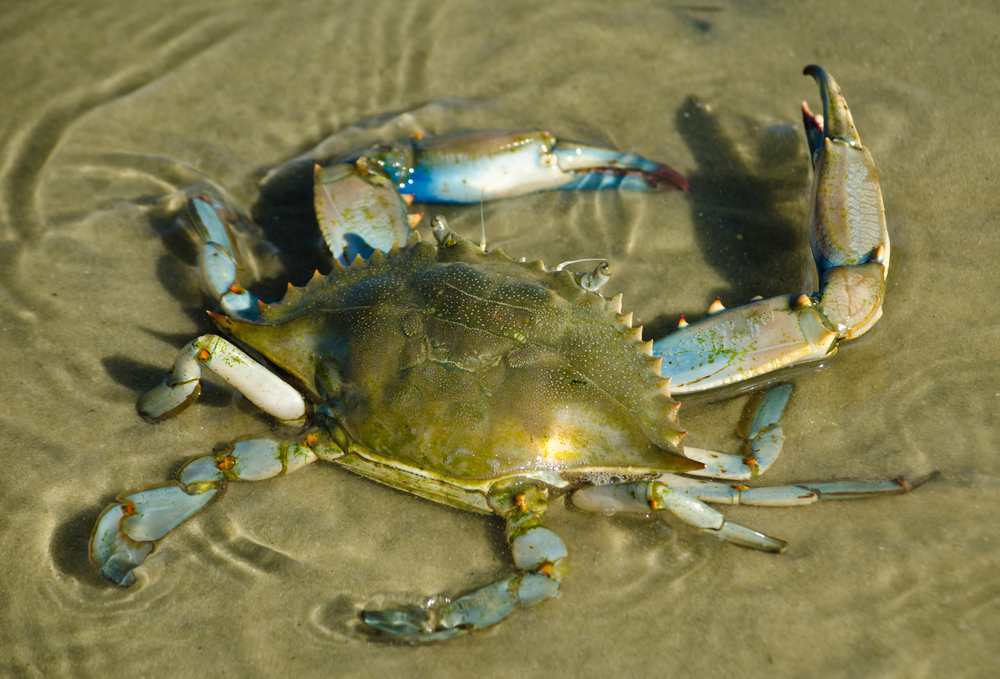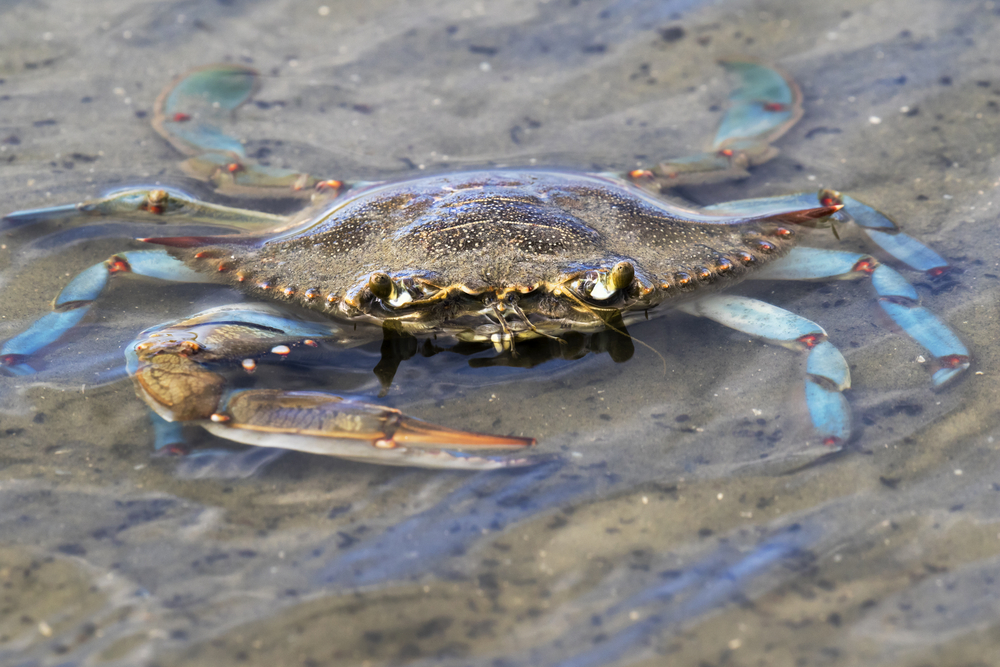About
The Blue Crab, scientifically known as Callinectes sapidus, is a species of crab renowned for its distinctive blue coloration and succulent meat. Belonging to the family Portunidae, which includes various other crabs, the Blue Crab holds a significant place in the Animal Kingdom as a prized seafood delicacy and an important component of marine ecosystems.
Named for its vibrant blue coloration, particularly on its claws and carapace, the Blue Crab exhibits sexual dimorphism, with males typically displaying brighter hues and larger claws than females. Their robust bodies are adorned with sharp spines and ridges, aiding in defense and camouflage. Blue Crabs also possess powerful claws, which they use for both defense and capturing prey.
The Blue Crab inhabits coastal waters along the Atlantic and Gulf coasts of North America, where they can be found in estuaries, bays, and shallow coastal habitats. They are opportunistic feeders, scavenging for a variety of prey, including small fish, mollusks, crustaceans, and plant matter. These crabs are known for their burrowing behavior, constructing intricate tunnels in muddy or sandy substrates for shelter and reproduction.
Blue Crabs are omnivorous predators, feeding on a wide range of prey items depending on availability and habitat. They use their powerful claws to crack open shells and access the soft tissues of their prey. Additionally, Blue Crabs play a vital role in marine ecosystems as scavengers, helping to clean up decaying organic matter and contributing to nutrient cycling.
Conservation Status
The conservation status of the Blue Crab is of least concern at this time. However, Blue Crab populations are subject to fishing pressure and habitat degradation, particularly in heavily urbanized coastal areas. Sustainable management practices and habitat conservation efforts are essential for maintaining healthy Blue Crab populations and supporting the ecosystems they inhabit.
Physical Characteristics
The Blue Crab (Callinectes sapidus) is a distinctive crustacean known for its striking physical characteristics:
Size and Weight:
- Carapace Width: Blue Crabs typically have carapaces ranging from 4 to 9 inches (10 to 23 centimeters) in width.
- Weight: Adult Blue Crabs can weigh anywhere from 0.5 to 1.5 pounds (0.23 to 0.68 kilograms), with males generally being larger and heavier than females.
Physical Characteristics:
- Blue Hue: As their name suggests, Blue Crabs have a distinctive blue coloring on their carapace and legs. However, the intensity of the blue coloration can vary, ranging from pale blue to a vibrant azure hue.
- Carapace Shape: Their carapace, or shell, is broad and slightly oval-shaped, providing protection for their vital organs. The carapace features a distinctive ridge along its midline, giving it a somewhat angular appearance.
- Pincer Claws: Blue Crabs have powerful pincers, or claws, known as chelae, which they use for defense, feeding, and courtship rituals. One claw is typically larger and more robust than the other, allowing them to grasp and manipulate prey effectively.
- Spatulate Swimmerets: The last pair of walking legs in male Blue Crabs are modified into spatulate structures, known as swimmerets, which aid in reproduction. Female Blue Crabs have smaller, less developed swimmerets.
- Red Tips: Another notable feature of Blue Crabs is the reddish coloration on the tips of their claws. This red pigment contrasts with the blue color of their carapace, adding to their visual appeal.
These unique physical characteristics make the Blue Crab an iconic inhabitant of coastal waters, prized for its succulent meat and distinctive appearance.
Reproduction
The reproductive cycle of the Blue Crab is complex and influenced by environmental factors such as water temperature and salinity. Here’s an overview:
Mating and Breeding Season: Blue Crabs typically mate and breed during specific times of the year, with the exact timing varying depending on their geographic location. In warmer regions, mating may occur year-round, while in cooler areas, it is often seasonal.
Courtship and Mating Behavior: During the breeding season, male Blue Crabs exhibit courtship behaviors to attract females. This may involve visual displays, chemical cues, and physical interactions. Once a female is receptive, mating occurs, with the male transferring sperm to the female’s seminal receptacle.
Egg Production and Fertilization: After mating, the female Blue Crab produces eggs, which are fertilized internally by the stored sperm. The eggs develop and mature within specialized structures called sponge-like masses located beneath the female’s abdomen.
Egg Incubation: Once fertilized, the eggs remain within the sponge-like masses for a period of incubation, which can last several weeks to months, depending on environmental conditions. During this time, the female carries the egg mass with her, providing protection and oxygenation.
Larval Release: Upon reaching maturity, the eggs hatch into larvae known as zoea. The zoea larvae are planktonic and drift with ocean currents, undergoing several molts and developmental stages before transforming into juvenile crabs.
Settlement and Juvenile Stage: As the zoea larvae mature, they undergo metamorphosis into megalopae, a transitional stage between larva and juvenile crab. Megalopae eventually settle in shallow coastal areas, where they undergo further development into juvenile crabs.
Growth and Maturation: Juvenile Blue Crabs continue to grow and mature over time, molting their exoskeletons periodically to accommodate their increasing size. As they grow, they transition into sub-adult and eventually adult stages, reaching reproductive maturity.
Reproductive Success and Population Dynamics: The reproductive success of Blue Crabs is influenced by various factors, including environmental conditions, predation, and fishing pressure. Sustainable management practices, such as size limits and seasonal closures, help maintain healthy populations and support continued reproduction.
Conservation Considerations: Blue Crab populations face threats from habitat loss, pollution, overfishing, and climate change. Conservation efforts focused on habitat restoration, sustainable fishing practices, and pollution mitigation are essential for protecting these ecologically and economically important crustaceans.
Lifespan
The blue crab, scientifically known as Callinectes sapidus, is a species of crab found in the western Atlantic Ocean and the Gulf of Mexico. These iconic crustaceans play a vital role in marine ecosystems and are economically significant in commercial fisheries. Here’s an overview of the blue crab’s lifespan and the threats it faces:
Wild Lifespan: In the wild, blue crabs typically have a lifespan of around 1.5 to 3 years, although this can vary depending on factors such as environmental conditions, predation, and reproductive success. Female blue crabs tend to live longer than males, primarily due to their reduced vulnerability during the mating process.
Lifespan in Captivity: Blue crabs kept in captivity, such as in aquaculture facilities or public aquariums, may have slightly different lifespans compared to those in the wild. While captive environments can provide consistent food sources and protection from predators, they may also lack the natural stimuli and habitats necessary for the crabs’ overall well-being and longevity.
Threats to Blue Crabs:
- Overfishing: Overfishing, particularly of large and reproductive-age blue crabs, can disrupt population dynamics and reduce reproductive potential. Harvesting practices that target gravid (egg-bearing) females can further impact recruitment and population stability.
- Habitat Loss and Degradation: Destruction of coastal habitats, including marshes, mangroves, and estuaries, can diminish critical nursery areas and foraging grounds for blue crab larvae and juveniles. Pollution, sedimentation, and habitat alteration from coastal development also pose threats to their survival.
- Predation: Blue crabs face predation from various marine and avian predators throughout their lifecycle, including fish, birds, larger crabs, and mammals. Predation pressure can influence crab behavior, distribution, and mortality rates in different habitats.
- Climate Change: Climate-related factors such as sea level rise, ocean acidification, and temperature fluctuations can impact blue crab populations and their habitats. Changes in water temperature and salinity levels may affect larval development, migration patterns, and reproductive success, leading to shifts in population distribution and abundance.
- Disease and Parasites: Blue crabs are susceptible to various diseases, parasites, and pathogens that can affect their health and survival. Outbreaks of infections or infestations can cause mass mortalities and impact population dynamics, especially in densely populated areas or aquaculture facilities.
Effective management and conservation measures are essential for ensuring the sustainability of blue crab populations and maintaining healthy marine ecosystems. Sustainable fisheries management, habitat restoration, pollution control, and climate resilience strategies are crucial for mitigating threats and preserving the ecological integrity of coastal environments.
Eating Habits
The blue crab, scientifically known as Callinectes sapidus, is a species of crab commonly found in the coastal waters of the western Atlantic Ocean and the Gulf of Mexico. Known for its voracious appetite and scavenging behavior, the blue crab plays a significant role in marine ecosystems as both predator and scavenger.
Diet: Blue crabs are omnivorous scavengers that feed on a diverse array of prey and organic matter. Their diet primarily consists of bivalves such as clams and oysters, crustaceans including other crabs and shrimp, small fish, marine worms, algae, and detritus. They are opportunistic feeders and will consume almost anything they encounter that is edible.
Feeding Behavior: Blue crabs use their powerful claws to crush and tear apart their prey. They are adept scavengers, often feeding on dead or decaying organisms, carrion, and plant matter. Additionally, blue crabs may actively hunt for live prey by ambushing or stalking their targets, particularly during the night when they are most active.
Foraging Strategies: Blue crabs employ various foraging strategies to locate food in their habitat. They may probe into sandy or muddy substrates with their walking legs and pincers to uncover buried prey such as bivalves and worms. They also scavenge along the seabed, searching for carrion and organic debris. Blue crabs are known to be highly efficient scavengers, quickly consuming available food resources.
Seasonal Feeding Patterns: The feeding habits of blue crabs may exhibit seasonal variations influenced by factors such as water temperature, salinity, and prey availability. During warmer months, when prey populations are abundant, blue crabs may increase their feeding activity to store energy for reproduction and molting. In contrast, their feeding activity may decrease during colder months or periods of low prey abundance.
Feeding Interactions: Blue crabs may compete with other bottom-dwelling organisms, including other crab species, for food and habitat resources. Additionally, they serve as important prey for various predators, including fish, birds, and larger crustaceans. Their feeding habits contribute to the transfer of energy and nutrients within marine food webs.
Conclusion: The blue crab’s diverse diet and feeding behavior play a crucial role in shaping marine ecosystems and nutrient cycling processes. Understanding its eating habits is essential for managing fisheries, conserving coastal habitats, and maintaining the ecological balance of marine environments where blue crabs are abundant.
Uniqueness
The Blue Crab, scientifically known as Callinectes sapidus, is a highly distinctive and economically significant marine crustacean found along the Atlantic coast of the United States and in the Gulf of Mexico. Here are some key aspects that make the Blue Crab unique:
Vibrant Coloration: Blue Crabs are named for their striking blue claws and the olive-green color of their shell, or carapace. The bright blue of the male crab’s claws contrasts with the redder claws of females, which also display orange tips. This vibrant coloration makes them easily recognizable and a favorite among seafood enthusiasts.
Remarkable Molt Cycle: Blue Crabs undergo a fascinating life cycle that includes several molts as they grow. They must shed their hard exoskeleton to increase in size, a process known as molting. After shedding the old shell, the crab swells its body with water to expand the new shell before it hardens. This process also allows mature females to mate just once and store sperm for producing several batches of eggs.
Impressive Mobility: Blue Crabs are agile swimmers, equipped with a pair of paddle-like rear legs that allow them to swim effectively through the water, making them adept at escaping predators and catching prey. They can move quickly through the water but are also capable of walking on the ocean floor.
Omnivorous Diet: These crabs have a varied diet that includes plants, fish, smaller crabs, snails, dead animals, and even their own kind. This omnivorous appetite helps them adapt to varying environmental conditions and available food sources.
Economic Importance: The Blue Crab is a staple of the seafood industry in many parts of the United States, particularly in Maryland and Virginia. It is highly prized for its sweet, rich meat and is a key ingredient in various dishes, including the famous Maryland crab cakes.
Complex Social Behavior: Blue Crabs exhibit complex behaviors, including a series of aggressive and mating displays. Males will fiercely defend their chosen mates and engage in battles for territory and breeding rights.
Ecological Role: As both predator and prey, Blue Crabs play a crucial role in the marine ecosystem. They help control the populations of smaller prey species and serve as a significant food source for many larger predators, including humans.
Challenges and Conservation: Despite their abundance, Blue Crab populations are subject to fluctuations and can be impacted by overfishing, habitat loss, and water pollution. Effective management and conservation strategies are crucial to maintain healthy populations and support the fishing industry.
The Blue Crab’s unique features, such as its vibrant coloration, complex life cycle, and ecological significance, make it an interesting and valuable species both ecologically and economically. Its role in cuisine and culture adds to its uniqueness, enhancing its profile as one of the most recognizable and cherished marine creatures in its native habitat.







































































